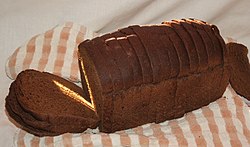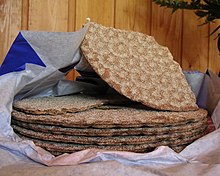Rye bread
 Sourdough rye bread | |
| Type | Bread |
|---|---|
| Main ingredients | Rye flour |
Rye bread is a type of bread made with various percentages of flour from rye grain. It can be light or dark in color, depending on the type of flour used and the addition of coloring agents, and is typically denser than bread made from wheat flour. It is higher in fiber than white bread and is often darker in color and stronger in flavor. Rye bread has notable health benefits when compared to white bread.
Dark rye bread became a staple which lasted to the Middle Ages. Many different types of rye grain have come from places all over Europe such as Finland, Denmark, Baltic countries and Germany. In Austria, Finland, Estonia, Denmark, Latvia, Lithuania, Poland, Belarus, and Russia, rye is the most popular type of bread[citation needed]. In 500 AD, the Saxons and Danes settled in Britain and introduced rye, which was well suited to cold northern climates.[1]
Biochemistry
While rye and wheat are genetically similar enough to interbreed (resulting in hybrids known as triticale), their biochemistries sufficiently differ to affect the breadmaking process. The key issue is differing amylases, the enzyme which breaks starch down into sugar. While wheat amylases are generally not heat-stable and thus do not affect stronger wheat gluten that gives wheat bread its structure, rye amylase remains active at substantially higher temperatures. Since rye gluten is not particularly strong, rye dough structure is based on complex polysaccharides, including rye starch and pentosans. As a result, amylases in rye flour can break down dough structure, inhibiting it from rising.[2]

There are two common solutions: The traditional manner, developed where obtaining wheat was traditionally impractical because of marginal growing conditions or supply difficulties, uses dough acidification to impede the function of rye amylases. Lowering dough pH, however, compromises the use of relatively acid-intolerant Saccharomyces cerevisiae-based "baker's yeast". Instead, addition of naturally acidic Lactobacillus "sourdough" cultures lowers bread pH, provides an acid-tolerant yeast strain, and helps gelatinize starches in the dough matrix. The byproduct of this approach is lighter breads.
In areas where high-gluten hard wheat is readily available the need for a complex polyculture of bacteria and yeast can often be reduced or removed by adding a large proportion of hard wheat flour to the rye flour. Its added gluten compensates for amylase activity on the starch in the dough, allowing the bread to retain its structure as it bakes. The "deli rye" tradition in the United States is based upon this mixing of grains. Use of high-gluten wheat flour also makes possible multigrain breads, such as the "rye and Indian" bread of the American colonies, which combined rye and wheat with cornmeal in one loaf.[3]
Rye bread contains phenolic acids and ferulic acid dehydrodimers.[4]
Types
Pure rye bread contains only rye flour, without any wheat. German-style pumpernickel, a dark, dense, and close-textured loaf, is made from crushed or ground whole rye grains, usually without wheat flour, baked for long periods at low temperature in a covered tin. Rye and wheat flours are often used to produce a rye bread with a lighter texture, color and flavor than pumpernickel. 'Light' or 'dark' rye flour can be used to make rye bread; the flour is classified according to the amount of bran left in the flour after milling. Caramel or molasses for coloring and caraway seeds are often added to rye bread. In the United States, breads labeled as "rye" nearly always contain caraway unless explicitly labeled as "unseeded." In Canada (especially Montreal), breads labeled as "rye" often have no seeds, whereas breads labeled as "kimmel" are usually rye with caraway seeds. Some unique rye bread recipes include ground spices such as fennel, coriander, aniseed, cardamom, or citrus peel. In addition to caramel and molasses, ingredients such as coffee or cocoa (or even toasted bread crumbs) are sometimes used for both color and flavor in very dark breads like pumpernickels.
Straight
A simple, all-rye bread can be made using a sourdough starter and rye meal; it will not rise as high as a wheat bread, but will be more moist with a substantially longer keeping time. Such breads are often known as black breads,[5][6] from their darker color than wheat breads (enhanced by long baking times, creating Maillard reactions in the crumb). The German Vollkornbrot (whole grain bread) is something of an archetypical example, containing both rye meal and cracked whole rye grains (which are generally soaked overnight before incorporating into the dough). It is used both as an appetizer substrate for such things as smoked fish and caviar and as a sandwich bread. A very similar, but darker, bread, German-style pumpernickel, has an even darker color derived from toasted leftover bread and other agents. Due to the density of the bread, the yeast in the starter is used at least as much for the fermentation character in the bread itself as it is for leavening. Danish rugbrød (rye bread), another archetypical example, is typically made with sour dough, with either straight rye flour, or mixed with whole and/or cracked rye kernels. Any breads containing wheat flour are not considered rugbrød, but white bread. A variety of seeds, such as pumpkin, poppy and caraway, may be added for taste. Rugbrød is a staple lunch food, typically eaten topped with cold or warm fish and meats, cheese or any other cold cut.
As stated above, all-rye breads may have very long keeping times, measured in months rather than days, and are popular as storage rations for long boat trips and outdoors expeditions. Such breads are usually sliced very thin because of their density, sometimes only a few millimeters thick, and are sometimes sold presliced in this manner.
Multigrain
It is fairly common to combine rye with other grains and seeds. In southern Germany and Switzerland, for example, it is not uncommon to find a variant of Vollkornbrot with sunflower seeds instead of the rye seeds, and some traditional recipes also substitute whole wheat grains for the rye grains.[7] In the colonial era in North America, particularly in the United States, it became common to mix rye and cornmeal in what was known as "rye and Indian" or, if wheat flour was added, "thirded" bread; the resulting bread, though less dense than a whole-rye bread, was still heavier than the more expensive wheat-only breads that later became commonplace.
In England, a mixed rye/wheat bread known as maslin (or variants of the name) was the bread of the peasants for hundreds of years,[8] in contrast to the manchet bread eaten by the rich.

Wheat-rye breads, particularly light rye (sissel) and American pumpernickel, but also a combination known as "marble rye", are very closely associated with Jewish-American cuisine, particularly the delicatessen. The bulk of the flour is white wheat flour (often a less-refined form known as "first clear"), with a substantial portion of rye mixed in for color and flavor. The dough is often, but not necessarily, leavened, in whole or in part, with sourdough, but sometimes uses a small addition of citric acid or vinegar to achieve the lowered pH needed to neutralize the rye amylases; so-called "Jewish rye" is further seasoned with whole caraway seeds and glazed with an egg wash, and is traditionally associated with salted meats such as corned beef, pastrami, and (outside kosher circles) ham. High-gluten wheat flour can be used with rye flour to make a dough suitable for bagels, as well. Jewish-style American rye bread is sometimes referred to as "corn bread" or "corn rye"; the term comes from the use of cornmeal as a coating and handling aid and does not necessarily imply the use of cornmeal within the dough itself as in rye and Indian.
The Jewish-American variety has Eastern European antecedents, including Russian-style brown bread and Riga-style rye bread.[9] In Scandinavia, similar breads are made, some of which (in Swedish, called limpa) also include sweeteners and/or citrus peel, as well as spices such as anise, fennel or cardamom, sometimes reserved for festive occasions.
In Canada, Winnipeg-style rye bread does not actually contain much, if any, rye flour. Instead, this Jewish- and Slavic-influenced bread is made from cracked rye or coarse rye meal, added to wheat flour.[10][11] Winnipeg-style rye bread from does not commonly contain caraway seeds.
Flatbreads

There are three different types of rye crisp bread: yeast fermented, sourdough fermented and cold bread crisp bread. Most of the crisp bread produced in Scandinavia is baked following three to four hours of fermentation. Sourdough crisp breads are used in Finland, Estonia, Latvia,[12][13] Lithuania, Poland, Germany and India.[14] The third type of crisp bread is the so-called cold bread crisp bread, essentially a type of hardtack (known in Sweden particularly as knäckebröd and in Finland as näkkileipä), which is baked without the addition of any leavening.[15] The dough gets the right texture from a foaming process, where air is incorporated into the cooled dough, which also leads to the sometimes almost white color of the finished bread, although not all types are light in color. Crisp bread owes its long shelf life to its very low water content (5–7%).
One of the largest producers of rye flatbreads, and one of the most prominent in overseas markets, is the Swedish-founded company Wasabröd.
Quick breads
Rye flour is sometimes used in chemically leavened quick bread recipes as well, either batter-type or dough-type (similar to Irish soda bread). In such cases, it can be used in similar applications as whole wheat flour, since an egg matrix often provides the bread structure rather than the grain's gluten.
Health benefits
Rye bread contains a large amount of fiber and a small amount of fat. Rye bread has a low Glycemix Index, which means it does not cause a spike in blood sugar as white bread and other breads do.[16]. In addition, whole-grain rye flour has more soluble fibre than whole-grain wheat flour making whole-grain rye more effective for controlling the cholestrol level in the blood.[citation needed]
See also
References
- ^ "Growing Grains: Wheat, Spelt, Oats, Barley, Rye and More". Organic Gardening. Retrieved 2013-05-26.
- ^ Daniel Wing and Alan Scott, The Bread Builders. White River Junction, VT: Chelsea Green Publishing, 1999.
- ^ Peterborough Historical Society (NH). "Society-Lifestyle: Recipes: Breads-Cakes: Rye and Indian Bread". Colonial Sense. Retrieved 2013-05-26.
- ^ European Food Research And Technology, 2002, Volume 214, Number 1, pages 33-42, doi:10.1007/s00217-001-0417-6
- ^ Schwarzbrot in German or chyorniy khleb in Russian,
- ^ Black Bread recipe from master baker Jeffrey Hamelman, roughly in the style of German pumpernickel
- ^ Robertson, Laurel, et al. The Laurel's Kitchen Bread Book, 2ed. New York: Random House, 2003, ISBN 978-0-8129-6967-2.
- ^ Elizabeth David, English Bread and Yeast Cookery, Penguin Books, ISBN 978-0-14-046791-8
- ^ Von Bremzen, Anya, and John Welchmann, Please to the Table. New York: Workman Publishing, 1990, ISBN 0-89480-753-6.
- ^ Writer, Staff (2008-10-08). "Give us this day our daily Winnipeg rye bread..." Winnipeg Free Press. Retrieved 2013-05-26.
- ^ 3 hrs. "Winnipeg Rye Bread Recipe". Allrecipes.com. Retrieved 2013-05-26.
{{cite web}}: CS1 maint: numeric names: authors list (link) - ^ "Latvian cuisine". Scoop.it. Retrieved 2013-05-26.
- ^ "Sosland Publishing". Bsimagazine.com. Retrieved 2013-05-26.
- ^ SEARCH. "Rye Dough - Culinary Encyclopedia". Ifood.tv. Retrieved 2013-05-26.
- ^ Åkerström, Jenny, and Gudrun Carlson (trans.), The Princesses Cook Book. New York: Albert Bonnier Publishing, 1936.
- ^ "Rosén Liza et al. Endosperm and whole grain rye breads are characterized by low post-prandial insulin response and a beneficial blood glucose profile, ''Nutrition Journal'', 2009, 8:42". Nutritionj.com. Retrieved 2013-05-26.

